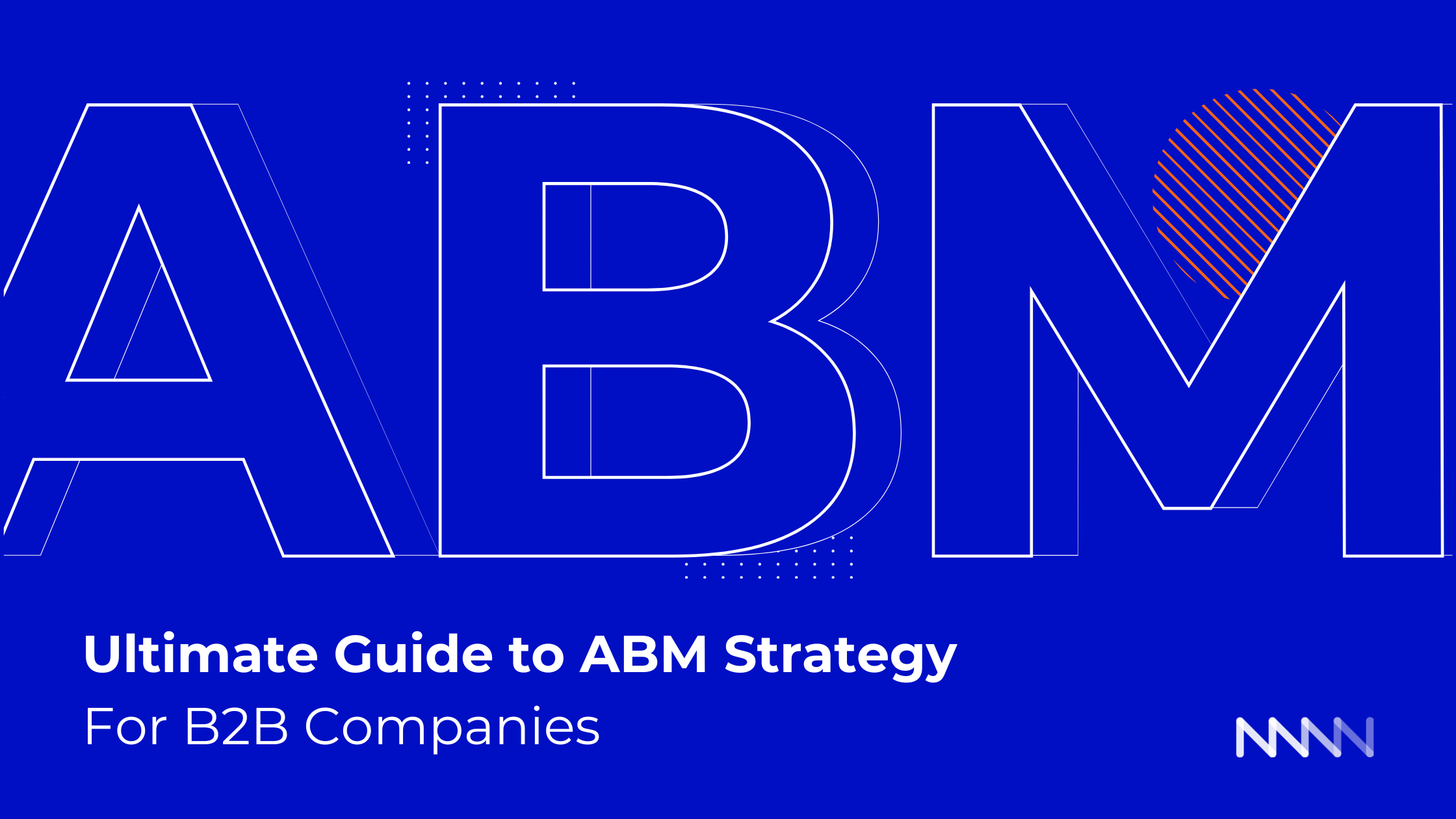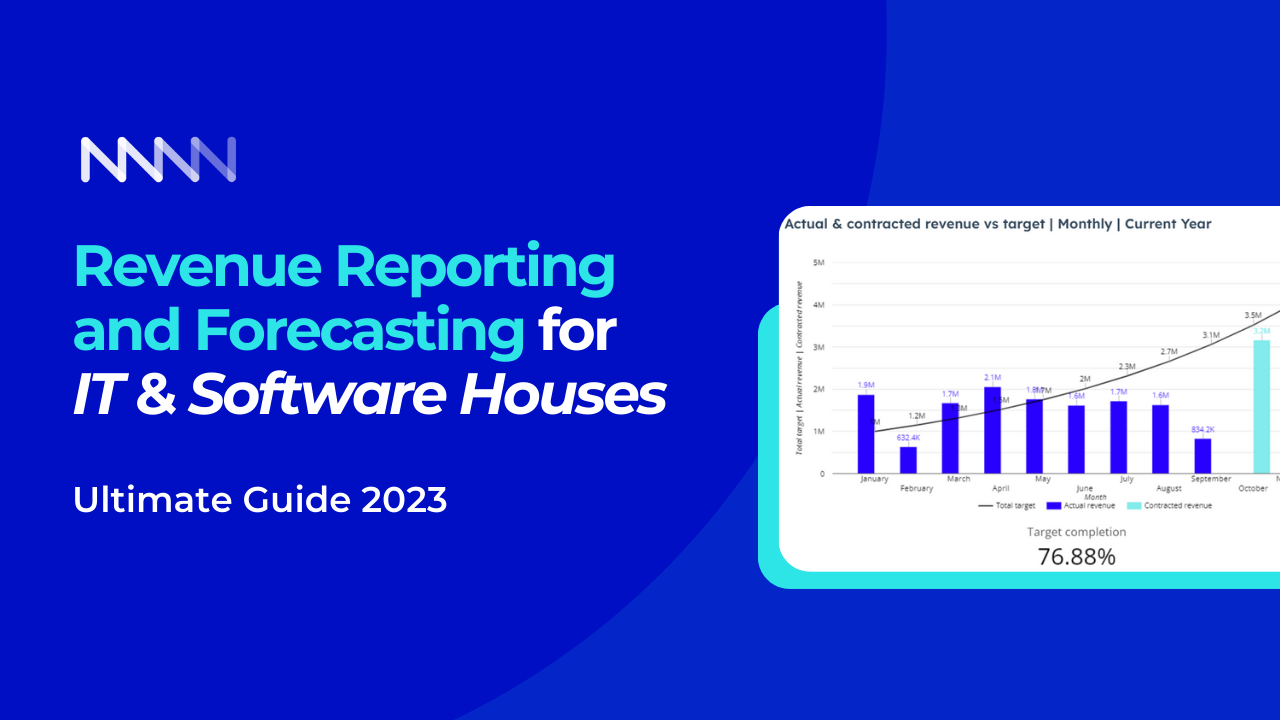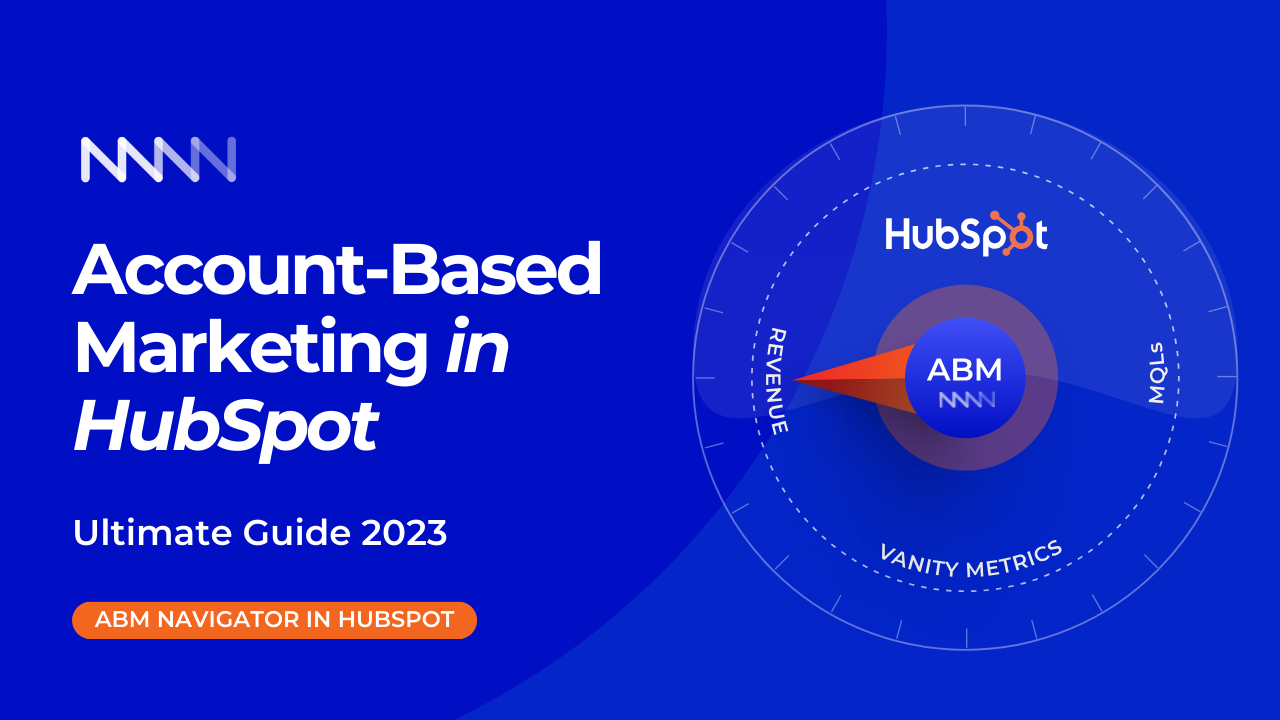What is Account Based Marketing?
In the past, there was a one size fits all marketing approach. Now, it is more tailored.
This article will help you understand what account based marketing is and how it can be applied to your company. It will also show you how it can benefit you in the future.In fact, we at MAN Digital were able to generate over 228 qualified leads for our agency services by purely focusing on target accounts in only 6 months.
In Short:
- Account-based marketing (ABM) is a strategy that focuses on targeting the right people with the right message at the right time
- It's not about blasting your target audience with irrelevant messages, but rather creating an individualized experience for each person based on their needs and interests
- ABM helps you get closer to customers by understanding who they are, what they need, and when they need it.
Grab your ☕ or 🍵 and let's get started.
Here is what we prepare for you:
Table of Contents
What Does Account Based Marketing Actually Mean

It's a B2B approach focusing on targeting specific accounts rather than pushing out content to everyone. Account-Based Marketing is not about doing less.
It's about targeting better.
Here's how we at MAN Digital approach this:
Our Total Market is businesses looking to build and optimize their Marketing & Sales funnels.
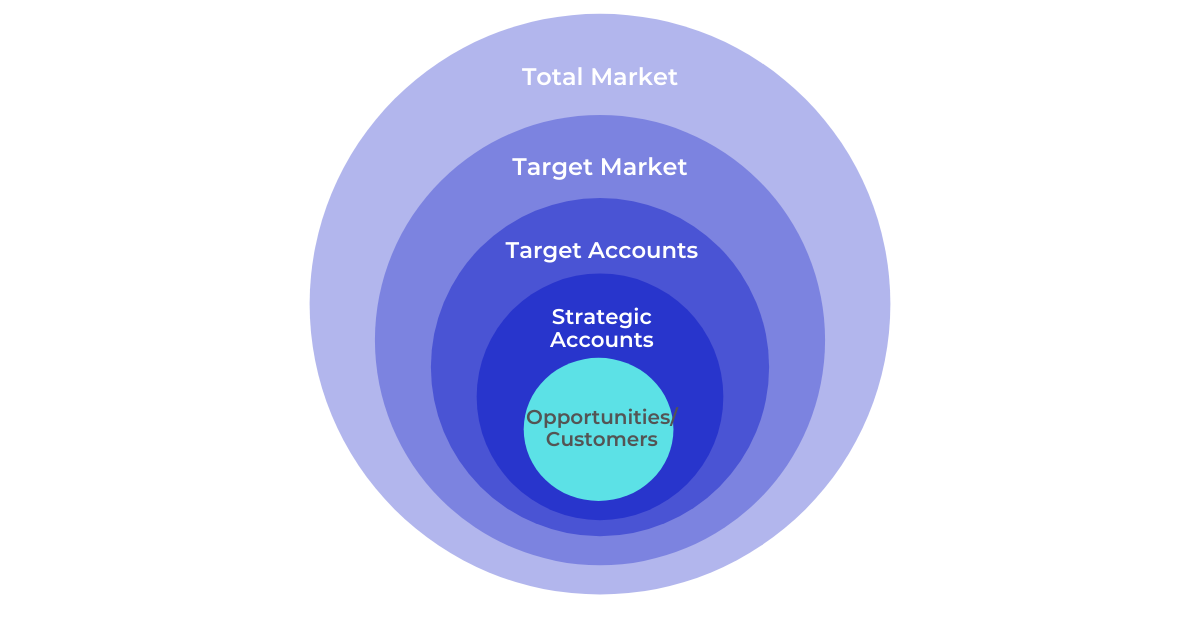
Our Target Market consists of B2B Tech companies.
Our Target Accounts are specific Software Houses in Poland with 10+ employees.
Lastly, our Strategic Accounts, Opportunities, and Customers are all evolution stages of the Target Accounts as they move along the buying journey.
To keep track of all activity within and around target accounts, we use HubSpot. This way, we stay focused on opening the deals that matter most.
As you can see, ABM is a framework of very targeted marketing efforts.
With ABM, you're moving from one-time sales opportunities to long term relationships focusing on high value accounts with a very personalized messaging approach to boost revenue.

As you can see, ABM is a framework of very targeted marketing efforts. With ABM, you're moving from one-time sales opportunities to long term relationships.
What Is Account-Based Marketing?
Account-based marketing is a term that has been around for years. However, it's recently been given new life.
The easiest way to layout the ABM philosophy is by using the TEAM Framework:
- Target - Target and Segment your accounts ( involve your sales team)
- Engage - Orchestrate engagement strategies with your targeted accounts
- Activate - Develop sales tactics and plays to convert sales.
- Measure - Get insights of your ABM programs and optimize
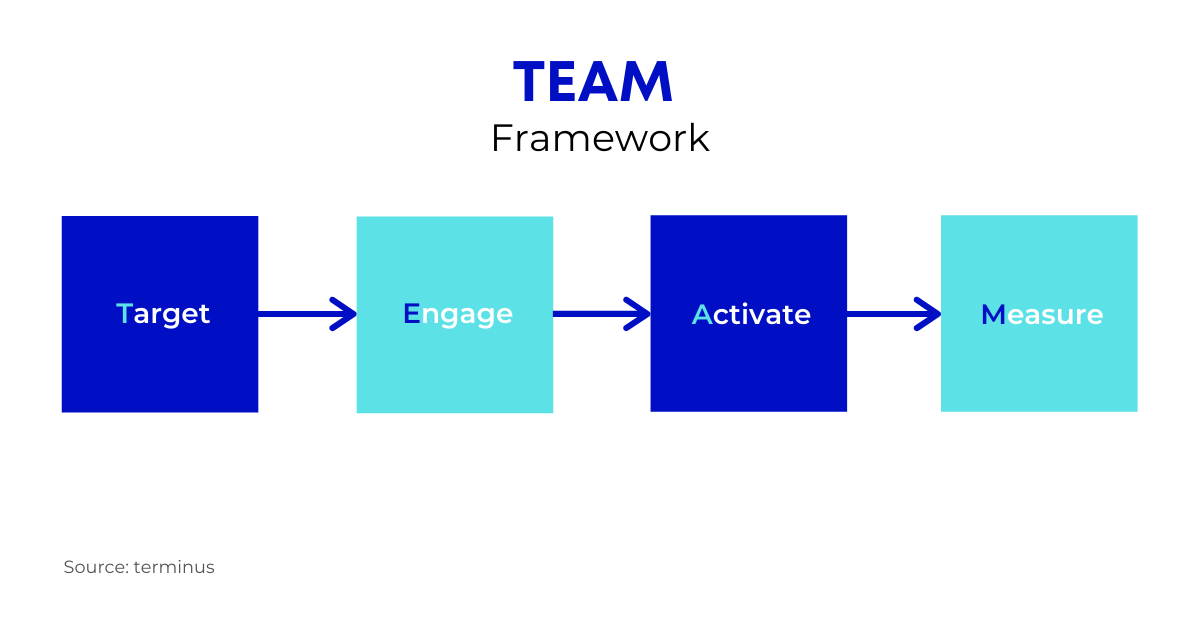
This framework helps marketers develop targeted lists of highly engaged customers or prospects who are primed for conversion through strategic activation campaigns tailored specifically for.
In ABM, target accounts are what ignites and shapes the whole framework.
They're not just a reference point. They're actual businesses you research, develop content for, and then target key accounts or existing customer accounts.
Below is an example of an ABM framework we use for MAN Digital.
| Target | Engage | Activate | Measure |
| Software Houses in Poland above 10 employees | Study Research on Top Software Houses Growth, Webinars, Ads | Personalized Sales Sequence, Relevant Case Studies | Opportunities generated with Software Houses in Poland |
Why Account-Based Marketing Important?
Simply it is more effective for B2B businesses with long sales cycle. According to Boston Consulting Group, ABM programs experience 50% faster sales velocity.
Now who doesn't want that?
- Here is an additional astonishing fact from Altera Group, 97% of marketers say ABM has a higher ROI than other marketing activities.
- ABM's practitioners experience a 285% lift in win rate (Engagio)
- Account-based marketing delivers a 40% decrease in customer acquisition costs (Forrester)
ABM strategy is worth considering when you want to optimize your marketing spend and get the best results possible. It is especially important for B-to-B companies with long sales cycle, and it's also very good at developing customer advocacy.
ABM aligns sales and marketing teams
Another big why is ABM worth considering is sales and marketing teams alignment and cross-training. It puts teams focus on high value accounts and creates an account focused culture in how you run your customer acquisition strategies.
Having an account based marketing campaigns mindset, customers who come from target accounts have an average conversion rate that is three times higher than those coming in through different channels (Forrester).
ABM will help you leverage customer data to segment and prioritize accounts. The account-based marketing campaign will help you build a strong relationship with key decision makers, so that they can become advocates for your business.
Let's go through 4 reasons why you should consider an account based marketing strategy.
- Return on Investment (ROI)
- Deals Win Rate
- Customer Acquisition Costs
- Sales Velocity
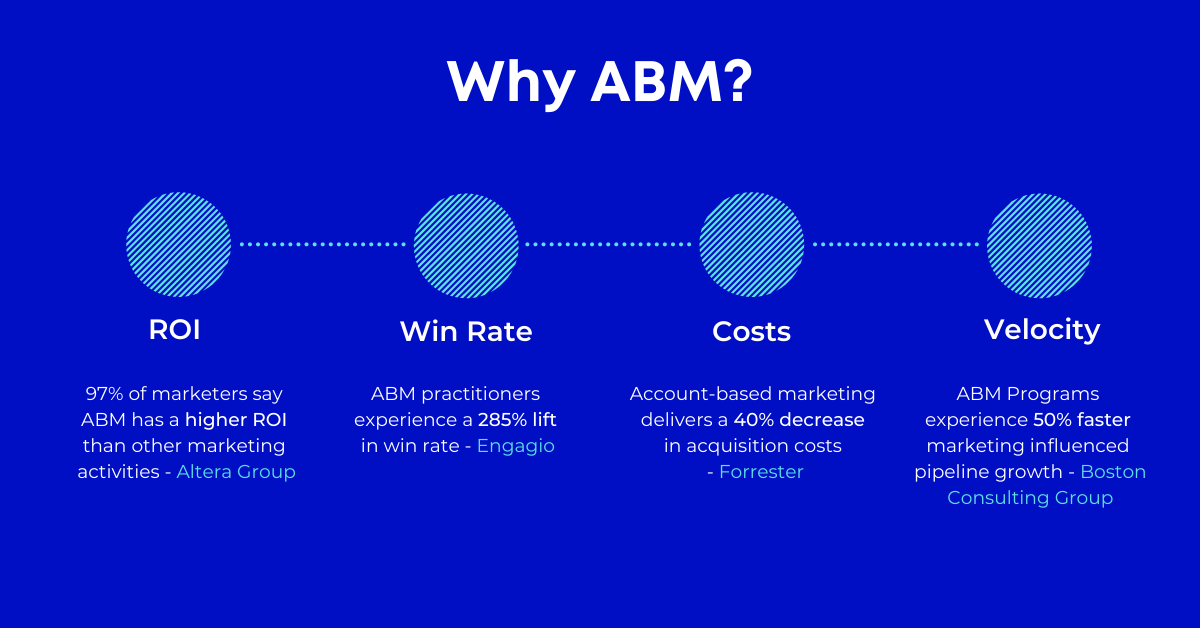
Return on Investment from target accounts
You'll see ROI mentioned a lot in this blog post because with ABM, it's a game-changer. When you go from chasing numerous leads to pursuing a set number of target accounts of high value, your efforts pay off in higher ROI.
And as we know from Einstein: "The most powerful force in the universe is compound interest." With an increased focus on account-based marketing, your company will be able to see these benefits grow exponentially.
If you want to see results, consider these suggestions for ABM:
- Establish and maintain a qualified target list of accounts that meet your criteria. This will result in faster sales velocity because fewer resources are being wasted on unqualified leads
- Focus on the customer journey with account-based marketing. The success lies within understanding how customers behave at different stages of their life cycle from awareness to purchase.
When companies focus only on top-line revenue generation by following linear approaches they miss out on opportunities downstream where more value can be generated through increased retention or cross-selling. - Customize content specifically targeted towards each individual company's needs and challenges; this allows prospects to better understand what is relevant to them as well as provides valuable insights.
Deals Win Rate
It's the fewer-accounts-but-of-higher-value logic all over again.
Going for a limited number of companies with a high buying potential allows you to customize your approach and close more deals out of the total accounts pursued.
These companies are not always easy to reach because you have to work towards them, but the payoff is worth it.
You can also use account-based marketing for B2B campaigns in order to focus on one particular company and develop a strategy tailored specifically for their needs.
Customer Acquisition Costs
All the above is a good enough pretence for lower customer acquisition costs. Plus, you can imagine how targeted marketing effort translates into little effort wasted.
In fact, Account-Based Marketing is so efficient it is even referred to as 'zero-waste marketing' - more on this later in this article.
According to a study conducted by Aberdeen Group, ABM is the most efficient strategy for B2B companies. In fact, it is even called 'zero-effort marketing'.
Account-Based Marketing is referred to as zero-effort marketing because it bridges people with companies. The approach focuses on the individual, and the company will make an effort to connect with them through a variety of channels that are most suitable for each person.
Sales Velocity
ABM is a growth strategy that elevates and expands the contribution that Marketing makes to the Sales pipeline. By how much?
The estimates vary, but most agree that ABM can produce a 20-30% improvement in pipeline velocity.
Furthermore, according to Aberdeen Group's study on Account-Based Marketing for B2B Companies: "Marketing and sales alignment is key to driving revenue growth".
This means aligning marketing initiatives with the needs of the individual company and developing a strategy tailored specifically for their needs. So it benefits both departments - Marketing will no longer be doing generic one size fits all campaigns while Sales won't waste time contacting unqualified leads any more.
This creates an overarching sense of teamwork which translates into better customer service as well as higher conversion rates from qualified prospects thanks to targeted messaging.
And imagine how much more impactful your social media channels would be if they were more tailored to your target audience and industry.
In the end, this is a win-win for both Marketing and Sales as it drives revenue growth for companies while also improving customer experience with better engagement rates.
Further, in this article we will give you some account based marketing examples implemented by our teams in businesses that have a long sales cycles.
Account-Based Marketing vs Inbound Marketing
First things first: there's nothing wrong with traditional marketing. It's a powerful approach that has helped countless businesses grow. But it also comes with its own set of shortcomings and challenges.
Traditional marketing focuses on the mass market - for example, women between the ages of 30-40 who live in an affluent suburb are all going to see the same TV commercial about your new lawnmower product no matter how well you know them or whether they need what you're selling.
Traditional Marketing focuses on more passive, one-to-one relationships. When someone signs up to your blog, for example, you can then engage them with content in the places they're already spending time - Facebook or Twitter posts that address their interests and offer specific solutions.
Account Based Marketing is a combination of these approaches, focusing on building long term relationships with target accounts instead of one to one individual.
Traditional marketing is not wrong, it's simply less efficient. Now, what drives long-term revenue growth is flipping the funnel.
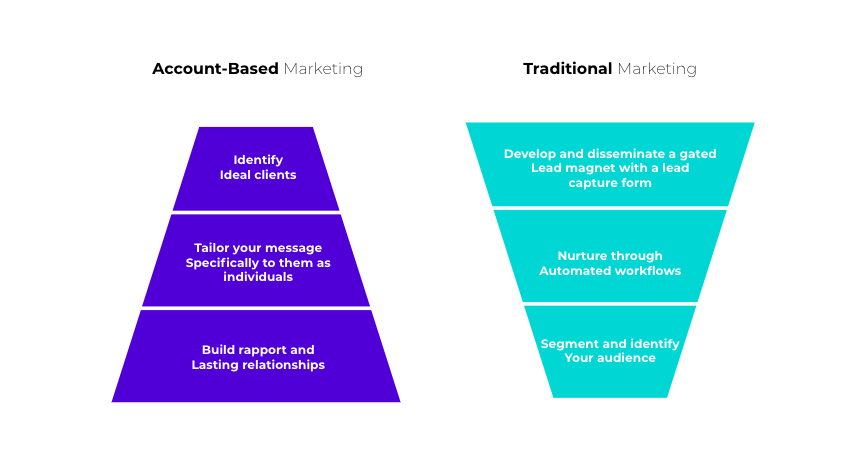 ABM Benefits vs Inbound Marketing
ABM Benefits vs Inbound Marketing
ABM and Inbound marketing have their differences. But it doesn't mean they can't be used in parallel. Let's break it down.
| Inbound Marketing | ABM | |
| Focus: | Markets/Industries | Accounts |
| Measure of success: | Quantity of Leads | Quality of Accounts |
| Objective: | New Business | Land & Expand |
| Research Tool: | Buyer Persona | Ideal Customer Profile |
Account-based marketing is different because instead of trying to reach as many people as possible, this biz dev strategy narrows down your focus by looking at specific accounts that best fit your criteria such as size, location, industry etc. The goal? To create personalized customer experiences tailored specifically for each prospect which leads
Marketing strategies have been around for a while, and they were all effective at some point.
Traditional marketing is not wrong, it's simply less efficient. Now, what drives long-term revenue growth is flipping the funnel.
Instead of raising brand awareness within a wide audience, you do target campaigns with personalized touchpoints such as email outreach.
You’re trying to create personalized customer experiences tailored specifically for each prospect which leads to long-term revenue growth through flipping the funnel.
Now, what drives long-term revenue growth is flipping the funnel instead of raising brand awareness within a wide audience with targeted campaigns like email outreach."
With Account-Based Marketing (ABM), you can reach out right away and start building up trust because prospects know who you are before they even sign-on!
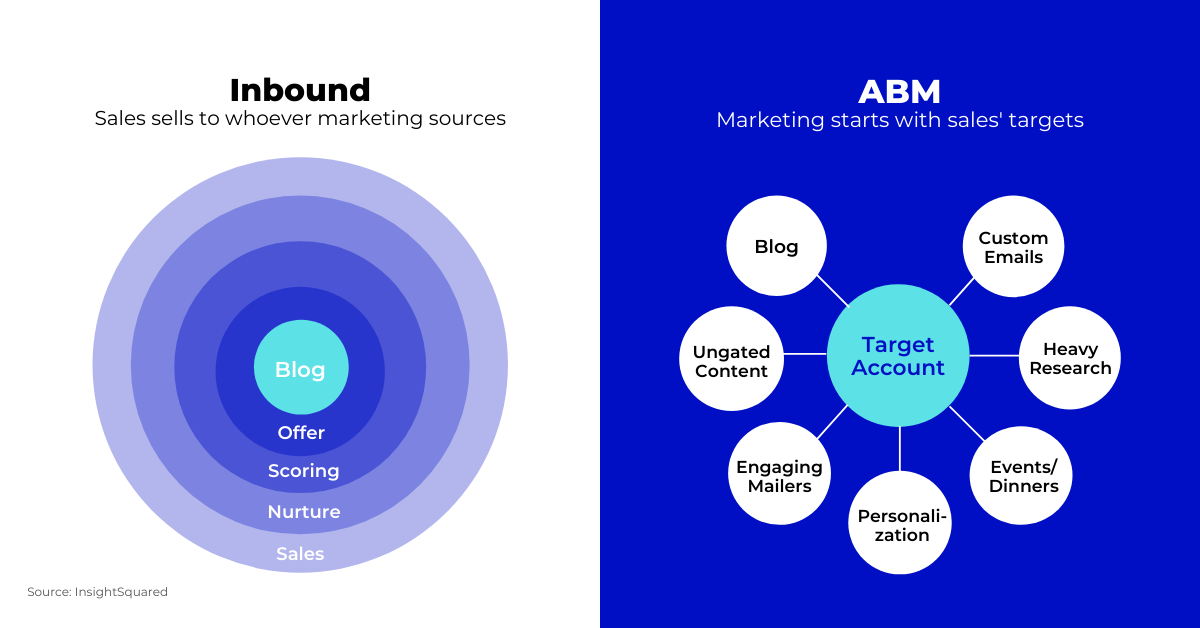
Instead of SEO and keyword-driven content you produce relevant assets that resonate with your target accounts.
It's important to know that content marketing is still a key component of ABM but it's not the same type of content as before.
The old way was about branding and awareness, whereas in ABM you're more focused on building relationships with your target accounts in order to generate revenue, for which you create a personalized content marketing strategy.
Why ABM Content is more effective:
- You'll have a personalized digital marketing strategy.
- Your target accounts will be more engaged with your brand.
You're tired of writing keyword-driven content that no one reads. Your boss is always asking you to write more blog posts, but they never get any views or shares! You're sick and tired of not being able to produce engaging content for your target accounts.
Imagine producing relevant assets that resonate with your target accounts. Instead of trying to rank in Google search results, you create valuable pieces of content that are shared across the web by influential people in your industry. This means more leads and sales for your business!
ABM is a new way to attract customers through social media marketing instead of SEO and keyword-driven content. It's an approach designed specifically for B2B.
ABM brings marketing and sales alignment instead of dividing the teams into silos
ABM can bring quick wins, but on the other hand, it requires a commitment to building relationships.
And solid B2B relationships, just like any other, take time and effort.
ABM can bring quick wins but requires commitment from the employees. That's why you should think about what will work best for your business before making any long term commitments!
In order for this to be effective, there needs to be alignment between your company's marketing and sales teams, so they're working together towards achieving mutually beneficial goals. This type of biz relationship management will help you gain new clients by word of mouth from their advocates who are already loyal customers!
ABM Disadvantages vs Inbound Marketing
ABM disadvantages against inbound marketing efforts are that ABM campaigns are usually much more expensive because they require significant investment in software, people and the processes for managing a complex sales funnel.
Traditional Marketing benefits from traditional marketing's scalability and cost-effectiveness as well as lower customer acquisition costs which translates to less risk than Account Based Marketing.
For example ABM efforts require you heavily invest in very personalized campaigns that require you to invest in a few customer relationships at once.
Inbound Marketing is much better than ABM when it comes to more hands-off customer acquisition.
Inbound Marketing's scalability can be beneficial if your company has low LTV and it doesn't make sense for sales reps to spend their valuable time on reaching out to potential customers based off of account targeting. For example, with automated marketing
For example a SaaS with a $59 a month price tag with rather benefit more from investing in marktech tools that can expand business with mass marketing rather than narrowing down to account targeting.
You should be sceptical about account based marketing tactics when it comes to lead distribution and CRM. Targeting a list of accounts can be beneficial, but in the long run it's not scalable enough for traditional marketing.
When you have a low ACV (average contract value) and you rely on ABM efforts, are likely to be the wrong choice because you're not going to see a return on investment.
Inbound Marketing is better because it's scalable and can be done with a low ACV, allowing for more ROI possibilities.
It's also worth mentioning that Inbound doesn't cost any money upfront so there are no sunk costs as you would have when targeting accounts through ABM tactics.
ABM is designed to get people into your account funnel but if they don't buy anything then what was the point? When using other marketing campaigns it becomes easier for prospects to find information about products or services which leads them down the deal funnel and towards an acquisition of purchase.
Lastly, Inbound Marketers use different metrics than Account Based marketers do - ABMs rely heavily on marketing and sales working together to accomplish the goal of getting someone to talk with a salesperson and Inbound relies heavily on engagement metrics.
This is because ABM has no form of feedback loop, it's just an effort for you to get into accounts in order to reach out but when using Inbound marketing there are ways that prospects can be reached back through email or social media.
It's also worth mentioning that one sign of bad account based marketing tactics is if your company does not have access to CRMs which means they're relying on stale data about contacts who may already be customers so their efforts could go towards people who have already bought from them before. This becomes more difficult since other marketing strategies don't require as many tools as ABM efforts.
As a conclusion when choosing your marketing programs it all depends on your ACV and complexity of the digital marketing strategy.
ABM success depends on your product market fit, the size of your target audience, and the complexity of your business process.
The conclusion being that both have their merits but if you're looking at CRMs and sales funnels then go with Inbound rather than trying something overly complicated like account based marketing.
If you're considering account based marketing strategies for your business then you should be very clear with your revenue potential.
Answer these questions before starting any ABM strategy:
- What is customer LTV?
- What is your target revenue per customer (RPC*)?
- How many customers do you need to reach this number of monthly sales (or what is the average purchase frequency)?
- What are your conversion rates?
Knowing your RPC, average purchase frequency, and conversion rates it will tell you what kind of sales volume a single lead brings into your company each year; if that figure falls short of what you need to meet your goals, then ABM may not be worth investing in at this time.
You need a good understanding of how the sales process works in order to determine if account based marketing tactics are going to work for your particular situation.
If they're not, then it's best that you use other marketing as this is much more "manageable".
To quote Joe Chernov, "ABM aspires to be zero-waste marketing."
Not all Marketing-qualified leads become Sales-qualified leads. And even fewer make it to paying customers. The result: tons of wasted effort.
Meanwhile, focusing on the accounts accepted both by Marketing and Sales means no more resources wasted on companies that simply aren't a good fit for your offer.
Joe Chernov also said, "ABM is challenging and complex." There are a lot of moving parts involved in making this approach work for your business, including:
- Filling out lots of forms
- Developing a strong strategy for messaging and content.
- Building out your sales team to be more account-focused
- And, learning how Marketing's data should work with Sales' data in order to deliver on marketing promises made and drive the right opportunities down the pipeline.
A lot of businesses struggle when they start trying ABM because they don't have a good understanding of their company's data, or what it can do to help them.
Account-Based Marketing Stats
In the world of marketing, numbers speak the loudest. That's why the best way to understand ABM's potential is to look at the stats.

Account-Based Marketing is not a new thing. But every new thing needs some time to take over the industry.
Today, over half of the brands have implemented ABM to some extent.
For those that have, the payoff was worth the transition.
The numbers show that ABM is an investment worth making with a high return. Compared to traditional biz-to-biz marketing, account-based has outperformed by 39%.
Don't take this at face value. Look at what we did together with Skyrise.tech.
In under 3 months, ABM brought them 58 qualified leads and 3 high ticket opportunities of 6-figure value.
|
207 Leads Q1 - 2020 |
58 Qualified Leads Q1 - 2020 |
3 high ticket opportunities in the pipeline valued at 6 figure deal (EUR) | A long term ABM strategy for both Inbound and Outbound Lead Generation | 90 hours of calls (reviews, project management, strategy) - Q1 2020 |
And this is just the beginning precisely because ABM is all about the long-term.
It's no wonder that the overwhelming majority of marketers who've adopted ABM see it as a winning strategy. And you know it's hard to get 87% of marketers to agree on any one thing 🙄.
Types of Account-Based Marketing
Next is defining the types of ABM.
Account-Based Marketing comes in three major types. They all reflect the number of target accounts pursued at one time.
There are 3 types of ABM approaches:
- One to one
- One to few
- One to many
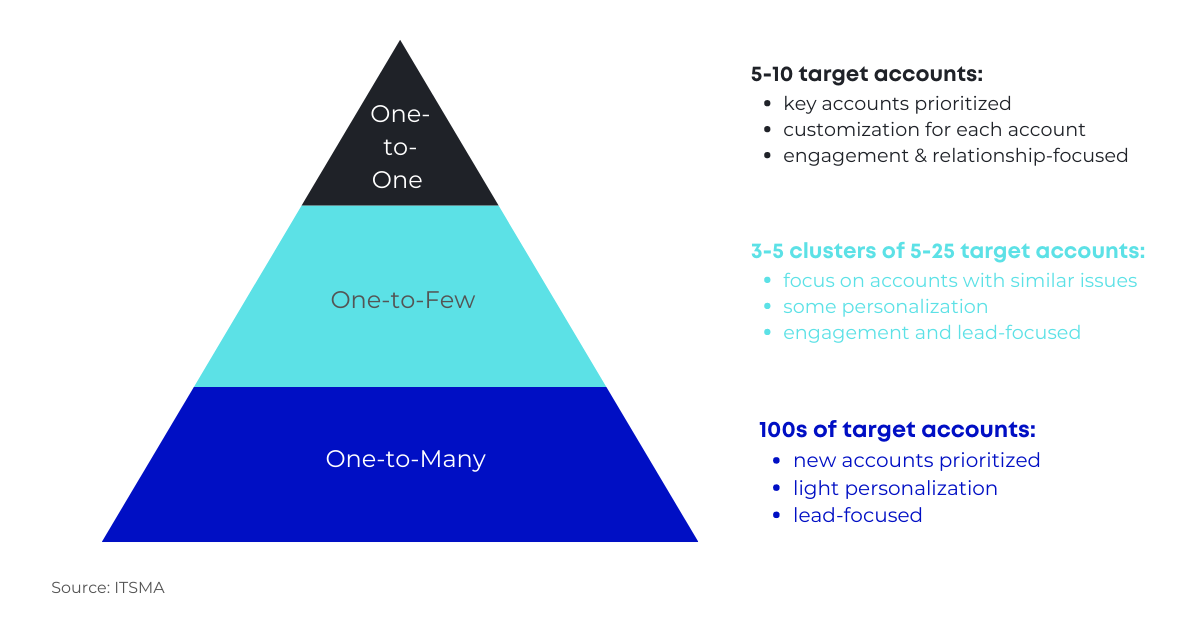
One-to-one ABM
It is a high-end variety of Account-Based Marketing. It's deployed when going after accounts with the absolute biggest value.
In reality, this means targeting 5-10 individual accounts with highly customized programs.
A one-to-one approach may be warranted in the case of a prospective client with 100 employees, has an annual budget of $100 million and is responsible for making major purchasing decisions. In this scenario, ABM would represent more than just marketing -- it's about integrating sales strategy into account management
One-to-few ABM
A way of marketing to account clusters. With this approach, target accounts are grouped by shared attributes, i.e. similar issues and needs.
A company that has one product for two different industries would use the cluster model in order to share its expertise with both industries.
Cluster Models work well when you have a specific solution to address a particular industry need or a specific target account.
The goal of this strategy is to provide examples, advice and point out opportunities across industries without pigeonholing the target account in one specific industry or product category.
One to many ABM
Is when you are marketing to a broader set of accounts. This strategy entails creating content that is relevant to multiple account types and industries in order to establish your expertise.
A company might use this approach when they have products for both the professional and DIY markets, or across different industry sectors such as education, finance and healthcare. The goal here is not necessarily personalized marketing for each account, but instead establishing general expertise.
This strategy is less expensive than one-to-one ABM because it enables marketers to create and distribute content without having to develop messaging for every target account. It’s also an easier way to maintain a “generalist” marketing orientation if you have limited resources.
Align sales with all the 3 approaches so that you're marketing and sales teams are on the same page.
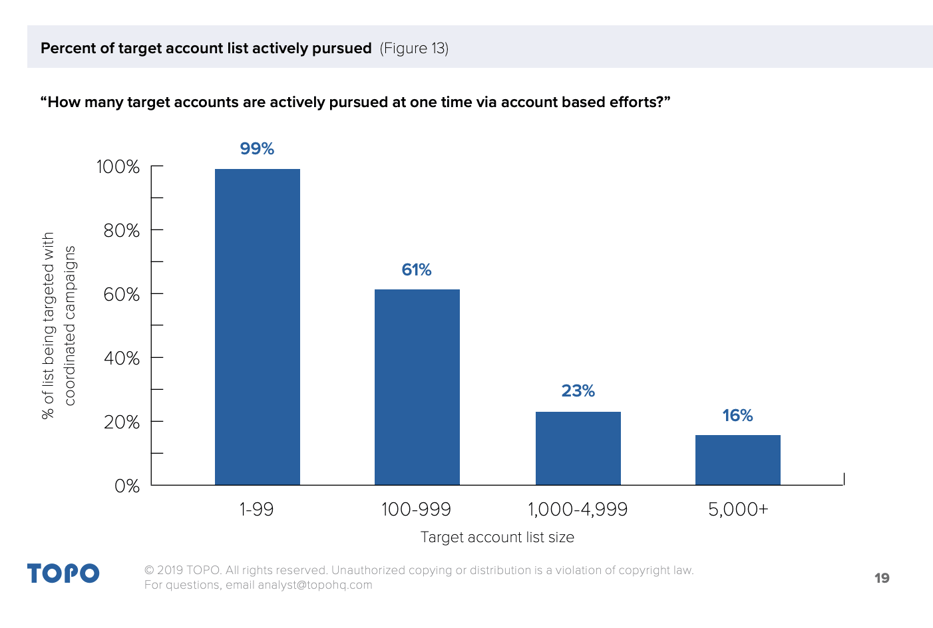
Account Based Marketing Playbooks
Before we proceed to the metrics used to measure the success of your ABM campaigns, there's one thing to be clarified about targeting and segmentation.
Focusing on a set number of accounts doesn't mean they're all new accounts you start building relationships with.
Your current client relationships also require upkeep, and you need to remember that when strategizing.
Out of the accounts you'll pursue at a time, there will be a share of long-term customers you expand relationships with.
Your partners also get a share of the ABM efforts pie. Ultimately, you're left with a breakdown that looks something like this.
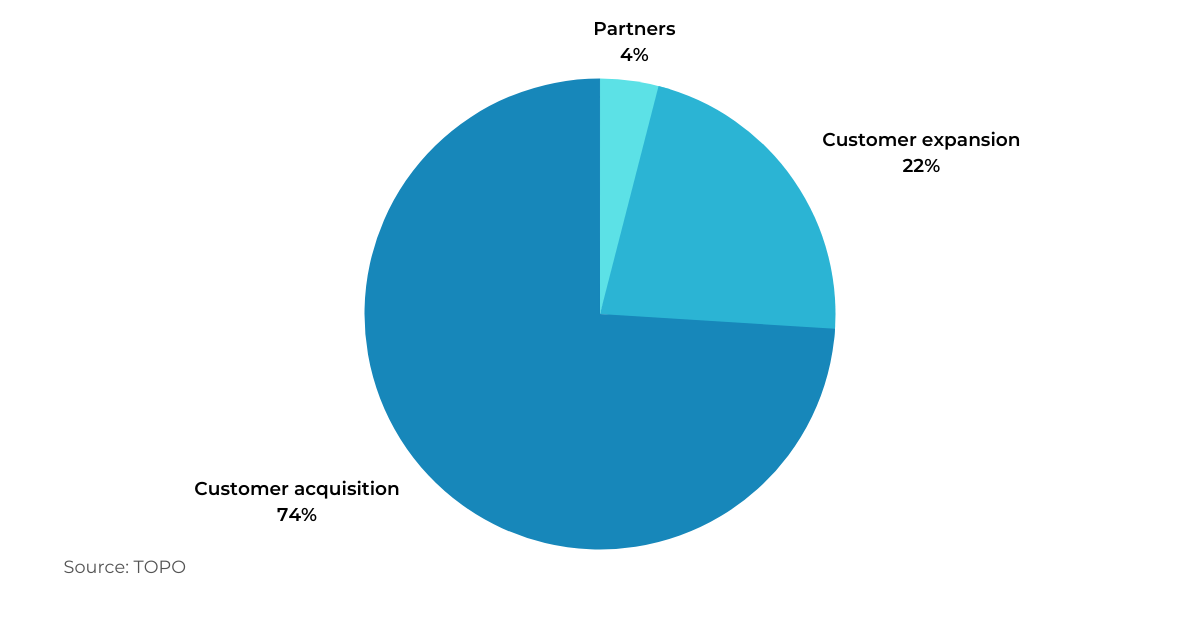 Another thing about segmentation is that you'll deploy different orchestrated plays with different target accounts.
Another thing about segmentation is that you'll deploy different orchestrated plays with different target accounts.
Here, you have 4 types:
- Engagement plays
- Meeting plays
- Velocity plays
- Expansion plays
Depending on the shares of current customers vs. net-new acquisition vs. partner accounts you'll be pursuing at one time, you'll use different types of orchestrated plays in varying proportions.
Engagement plays
Your engagement play, the easiest and most straight-forward to deploy is when you're trying to create more opportunities with accounts that are currently on your list. The goal of these engagements (which can be phone calls or meetings) is for a rep to deepen their relationship with an account, so they'll become one of your long-term customers.
These customer relationships typically come from either inbound inquiries about products/services, outbound cold callings, or in some cases referrals from partners and other existing customers.
Engagements should have the goal of creating a deeper understanding if there's potential for business together.
Meeting plays
These are when you have no new opportunities with the account and are looking to "put in a good word" for your products/services.
Meetings can be either scheduled or cold-called, but typically these events occur within an existing relationship where trust has been established. The goal of this play is simple: show someone how much better their life will be when they use what you're selling!
Velocity plays
Velocity plays are highly targeted outreach efforts that may not result in any immediate sales, but instead aim at generating awareness about your company while also building relationships over time - which could lead to long term success down the line.
These plays are highly effective for high value accounts when you need to build a strong relationship in order to close the sale.
The goal of velocity plays in the sales process is to create awareness of the company and also build relationships over time.
Expansion plays
The goal of an expansion play is quite different from other types of outreach because it's about reaching out in order to grow the relationship (rather than generate immediate sales).
Expansion plays are also typically more personalized, which means that they require time - something many marketers don't have enough of these plays.
Sales and marketing alignment is crucial when running expansion plays because it needs to be done in a way that doesn't interfere with the primary sales process.
Account-Based Marketing Metrics
We talked about a clearer ROI earlier in this post. But what are the specific metrics used by marketing teams and sales teams to measure and optimize ABM campaigns?
Below are a few data pointers to help you navigate the ABM space.
- Engagement by account
- Meetings within accounts
- Opportunity Rate
- Account Conversion Rate
Implement account based marketing to track these metrics and see what is working marketing campaigns.
HubSpot is the marketing automation system that we used to build ABM program and track data.
What's important to understand about measuring the efficiency of your ABM campaigns is that you need to define your own measurement model.
The metrics we reviewed here are just the starting point. Marketing and Sales need to agree on the set of KPIs most relevant to them within any given ABM campaign.
Same with ABM: to measure the success of your campaigns, you need to track your target accounts' conversions into paying customers.
| METRIC | BENCHMARK | CALCULATION |
| Engaged Account Rate | 42% | Engaged Accounts / Target Accounts |
| Opportunity Rate | 21% | Accounts with one or more new opportunities / Target Accounts |
| Account Win Rate | 11% | Closed-Won Accounts / Target Accounts |
What's important to understand about measuring the efficiency of your ABM campaigns is that you need to define your own measurement model.
The metrics we reviewed here are just the starting point. Marketing and Sales need to agree on the set of KPIs most relevant to them within any given ABM campaign.
Account-Based Marketing Maturity Model
If you think about it, Account-Based Marketing is B2B.
Marketing to accounts as opposed to buyer personas means targeting businesses. So does it mean you've been doing ABM this whole time?
The answer is yes and the answer is no. It depends on how far along you are with aligning Marketing and Sales.
The closer your Sales and Marketing are aligned (not only philosophically but also in terms of metrics and goals), the higher your ABM potential.
.png?width=1200&name=ABM%20Maturity%20Model%20(1).png)
In addition to Sales and Marketing alignment, you can assess your business' ABM maturity by looking at where you stand in terms of target accounts, marketing programs, and measurement.
Building and implementing an ABM strategy takes time, and so does moving from one tier of ABM maturity to another.
Use this model as a growth framework and trust your processes. The rest you can always measure and optimize along the way.
What is an ABM Platform?
An account based marketing team without an ABM platform it is like a sports team without a playbook. It can't plan or execute any plays - it is literally stuck playing defense!
An ABM platform helps you to organize all of your marketing data, including contacts, campaigns and email conversations for one account at a time. This way you can prioritize the best accounts with the most potential opportunities for success and segment.
ABM's platforms are many times confused of being just a marketing automation tool, but the ABM platform is so much more. It's really your account-based campaign hub, with everything needed for executing on campaigns and lead nurturing activities that are personalized to each account - all in one place!
Here some ABM platforms which you may want to explore:
- HubSpot
- Marketo
- Pardot, Oracle Marketing Cloud
- Eloqua CRM
Any successful ABM program needs a home, for us this is HubSpot. It gives us the opportunity to:
- Segment Accounts
- Map buying roles, buying personas and identify decision makers
- Specify the companies as target account
- Integrate it with account based marketing advertising
- Build custom ABM dashboards
- Run both marketing and sales plays
- Have all the teams work on the ABM program including the customer success teams
- Map engagement with multiple stakeholders
Any ABM strategy needs one thing: time.
So, choose your ABM Platform wisely and start executing. It is the biggest pain point for many marketers as it has a huge learning curve.
What is Account Based Advertising?
Account based advertising is when a marketing message is sent to a specific account.
campaigns can be targeted by company size, vertical or any other characteristic of the target market that could help make an ad more relevant and useful.
In this type of advertising messages are served based on information about whom you’re targeting.
Here is a list of ABM advertising platforms to consider:
- Rollworks
- Terminus
- Demandbase
- Adelphic
- Trupoint
- Blis Media
- Zeta Interactive
- Nectar Systems.
- n.rich
- LinkedIn Ads
All of these platforms offer some form of DSP. (A demand-side platform is an advertising technology that allows advertisers and agencies to make and run ads across thousands of publishers.)
They also have other features that can transform your marketing and sales strategy, including: targeting capabilities based on a variety of data factors; media amplification with digital campaigns to extend reach outside the firm’s own customer base through programmatic advertising;
Data Providers for ABM
One of the key elements in ABM is accurate data.
There are several data providers in the market that provide companies with accurate and up-to-date information.
ABM programs need data to prospect and enrich your target lists, create personalized customer segments
When your sales team is using accurate contact data, they can do account-based sales by targeting the right people at the right companies and stop wasting their time on busy work.
Here is a list of the top Data Providers for B2B data providers
- Adapt
- Apollo.io
- Clearbit
- Similartech
- Datanayze
- InsideView
- LeadIQ
- LinkedIn Sales Navigator
- Lusha
- Slintel
- Uplead
- Zoominfo
- Crunchbase
- G2 Stack Data
While we use some of these data providers for our own needs, we highly suggest to at minimum have LinkedIn Sales Navigator and if you have HubSpot you'll get access to HubSpot Insights to automatically enrich your data.
While all this data is great we also do our own account research capture real time news and facts to be relevant to our target account list with in our marketing messages.
Social ads for ABM?
You might ask, is Twitter or Facebook in good for ABM advertising ?
I would say, no, they are not.
This is because these platforms do not have a robust DMP or marketing automation platform, and offer limited data points for targeting accounts.
Maybe they can be used in re-marketing approach.
There are some possibilities with Facebook also by integrating it with Clearbit , but this requires a lot of marketing effort for a platform that doesn’t offer the same level of targeting and measurement.
You need at least €15K/mo Facebook Ads budget and approx €10K per year for Clearbit.
LinkedIn is really where marketers should be looking to start their account-based marketing campaigns, because it offers robust DMP capabilities in addition to social data points.
Wrapping up
Account Based Marketing may be the most important marketing trend today.
The size of your customer base is no longer a limiting factor for your business, and ABM can help you get to those customers who are not inbound prospects- but still have a high propensity to buy from you.
This article has provided some stats about the importance of account based marketing, as well as types of account based approaches available for B2B organizations like yours.
We've also identified some resources that will provide data providers for teams doing account based advertising or other aspects of this type of strategy.
Do you run a B2B organization? Then give ABM a try!
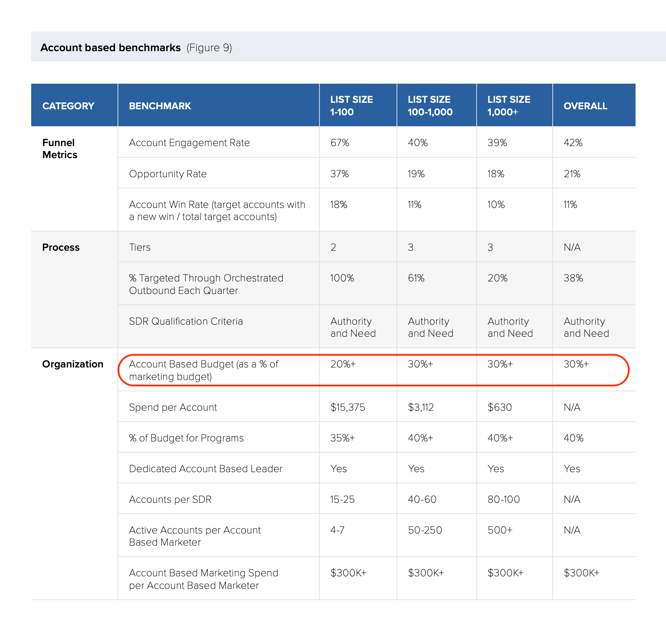 The entire approach to Account-Based Marketing can be summarized as a recipe of four parts.
The entire approach to Account-Based Marketing can be summarized as a recipe of four parts.
- Target a limited number of accounts identified by Sales and Marketing together.
- Research and approach each account / account cluster in a personalized way.
- Develop targeted content and campaigns.
- Measure and optimize for a pre-defined number of high-value accounts.
Any one of these would be enough to improve a traditional marketing campaign. When you put all four together, though - that's when magic happens.
And if you need help of qualified ABM wizards - get in touch with us.

